- David Arango-Valencia – Debridement Gold
- Mark Pilkington – Lens 7
- Claudia Robles-Angel – HINEIN (inwards)
- Inés Wickmann/Francis Dhomont – LE SILENCE DU LÉTHÉ
- Francesc Martí – Speech 2
- Dave Payling – Synthetic Electro Replicant
———- Interval (10 mins) ——————–
- Diego Garro – TACTO
- Elsa Justel – dots, lines and roughness
- Alfonso Pretelt – Eurydice
- Brian Hernandez – F.A.K. 120 Video Triptych (Part 2)
- Fernando Alexis – Untitled#1
- Maxime Corbeil-Perron – Northern
- Carlos Delgado – Prelude To The Fifth Sun
____________________________________________________________
David Arango-Valencia – Debridement Gold
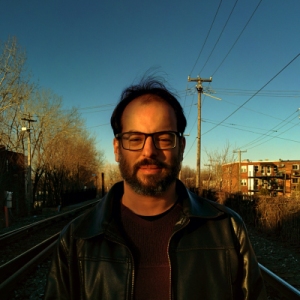
”There is a crack, there is a crack in everything-That’s how the light gets in” Leonard Cohen
David is a composer from Montreal interested in acousmatic and visual music, electronic music and soundscapes, mixing various mediums that can express meaningful and immersive experiences. His work has twice been awarded the Jeux des Temps Times Play, organized by the Canadian Electroacoustic Community, and it has been showcased internationally in over five countries. David has studied composition at Université de Montréal under the direction of Jean Piché, Robert Normandeau and Martin Bédard.
Mark Pilkington – Lens 7

Lens 7 investigates audio-visual synthesis through the multi-disciplinary practice of fabrication, analogue modular synthesis and digital image processing. The starting point was the fabrication of a ‘bricolage’ Texture 1 (2013) that provided a physical framework. A single photographic image of Texture 1 is digitally transformed using generative processes to form a graphic score-in-motion. The motion of the image reveals a temporal virtual landscape that contains spatial, textural and spectromorphological properties associated with electroacoustic music.
The sound material for Lens 7 consists of improvised recordings of a Buchla 200 modular synthesiser based at Stockholm EMS, May 2014. The analogue sounds were repositioned to correspond to inherent musical properties of the graphic score-in-motion. Composing with modular synthesisers shares many similarities to the creation of visuals; the modular synthesiser acts as a tactile surface in which composer/performer produce sound by altering sonic architecture. The performer listens and responds to the sounds by making parametric changes: listening is inherently linked to physical gesture. Similarly, visual transformations occurred through interaction between performative or generative systems. Throughout the compositional process aesthetic judgement is contained in an audio-visual contact set within a system requiring programmed (no-input) and/or active participation (input). In the audio-visual realm, the predominate factor is the appliance of ‘motion’ to promote cross-modal correspondences between sound and image.
Realised at Stockholm EMS, Thought Universe, LICA Lancaster university and NOVARS, the university of Manchester.
Mark Pilkington is a composer and performer of electroacoustic music. His practice encapsulates both sound and image as a means to extend spatial imaginings between real and virtual space. The coupling of sound and image are applied to electroacoustic music, site-specific installation and screen-based works. Forging immaterial and creative labor through a network of interwoven and augmented territories, his work increasingly queries the way operations carry great critical and creative potential. Seeking new modes of critical engagement that incorporate multiple narratives through non-digital and digital aesthetic informs the direction of his pedagogy. His theoretical research focuses on the relationship between artistic genres and their respective aesthetic theories with reference to: electroacoustic music, sound synthesis, visual music, coding, philosophy, and film. His practice especially focuses on audio-visual composition using real and virtual entities as a means to explore time and space. His work have been performed, exhibited and screened at conferences and festivals throughout the UK, Europe and USA. Collaborative interdisciplinary work is carried out with composes and visual artist/s.
His work has been performed and screened at ICMC, ARS Electronica, MANTIS festival and Open Circuit Festival.
www.markpilkington.org.uk
Claudia Robles-Angel – HINEIN (inwards)
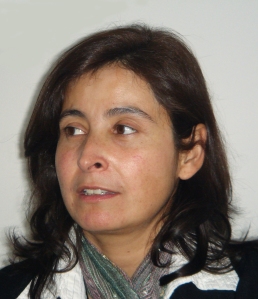
HINEIN (inwards) is an invitation to travel inside the world of natural microstructures, combining subtle sounds and extreme close-up images of diverse natural surfaces whose micro-dimensions are not perceived in our daily life. Both visual and auditory layers of the composition suggest the idea of a tactile/haptic feeling, inviting the audience to use their eyes/ears also to feel and not only to see/listen to, based on the following words by French philosopher Deleuze: ‘Where there is close vision, space is not visual, or rather the eye itself has a haptic, non optical function: no line separates earth from sky, which are of the same substance; there is neither horizon nor background nor perspective nor limit nor outline or form nor center; there is no intermediary distance, or all distance is intermediary.’
Claudia Robles-Angel is an audiovisual artist born in Bogotá-Colombia, currently living in Cologne-Germany and active worldwide. Her work and research cover different aspects of visual and sound art, which extend from audiovisual fixed-media compositions to performances interacting with bio-data via the usage of interfaces such as, for example, the EEG (electroencephalogram, measuring brain waves activity).
Her work has been presented in festivals and in group and solo exhibitions around the globe, for example, the ZKM Center in Karlsruhe (2005); Enter3 in Prague (2007), at the European Capitals of Culture Luxembourg and Romania (2007); 2008 at KIBLA Multimedia Centre in Maribor; at the ICMC in Copenhagen and Montréal (2007/2009); at the Skulpturenmuseum Glaskasten Marl (2009), the SIGGRAPH Asia in Yokohama (2009), Museo de Arte Moderno and ESPACIO Fundación Telefónica in Buenos Aires (2010), the New York City Electroacoustic Music Festival NYCEMF in 2010 and every year since 2013; the SIGGRAPH Asia in Yokohama (2009); the Re-New Festival in Copenhagen (2011); the NIME Conference in Oslo (2011); ISEA Istanbul 2011, at LEAP Space for media Art in Berlin (2012), Noisefloor Stoke-on-Trent (2012), CMMR Marseille and Plymouth (2013/2015), at the Salon Suisse, an official collateral event of the 55th Venice Biennale (2013), at the Audio Art Festival Cracow (2013)at Harvestworks Digital Media Arts Center New York City (2014), at SKOP Festival Frankfurt (2014) at Nabta Art Center Cairo (2015), Museum of Contemporary Art Bogotá (2011/2015), MADATAC Festival in Madrid (2016), IK Stichting in Vlissingen (2016), at Tivolivredenburg during the ICMC 2016 in Utrecht and more recently at Die Digitale Düsseldorf.
Inés Wickmann/Francis Dhomont – LE SILENCE DU LÉTHÉ

The mythologic Lethe, with its slow and silent stream, was the river where souls drank water to clear the evocations of the past.Mnemosyne, the Memory, intensely observes the transformation of nature, the pass of the prisoner time in a piece of amber or its leak printed in the trunk of a tree.The forget closes its eyes, memories become noise and immerse in the river where their traces are lost.
Inés WICKMANN was born in Bogota, Colombia. She graduated from Universidad Javierana with a BA in Interior Design and a BA in Plastic Arts at Universidad Nacional, Bogota. Later on, Inés earned a Master in Visual Arts and New Media at the University of Quebec (UQAM), Canada.
While in Colombia, she studied music and created the program « Sonidos contemporaneos » for the Universidad Nacional radio station.
Her production started with paintings and evolved towards tridimentional objects, installations and video.
She has participated in numerous individual and collective expositions in Colombia, Mexico, US, Canada and France. Her videos have been displayed at various international festivals.
Ines currently lives and works in Avignon, France.
Francesc Martí – Speech 2
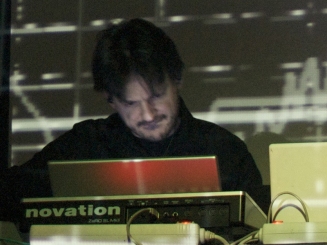
Speech 2 is an experimental audiovisual piece created from a series of old clips from the US broadcast public affairs interview program The Open Mind. This piece is reflection on the action of communicating, highlighting its limitations, and can be labelled as “text-sound-art”, or “text-sound-composition” in an audio-visual framework.
Technically, in this piece, the author has been experimenting how granular sound synthesis techniques, in particular synchronous granular synthesis, and pseudorandom number generator algorithms can be used for audio-visual creative works. The original movies are cut, mixed, manipulated and reassembled, generating new images and sonorities. All the piece sounds and images come from that series of clip, in other words, no other sound samples or images have been used to create the final result.
Francesc Martí is a mathematician, computer scientist, composer, sound and digital media artist born in Barcelona and currently living in the UK. He has a bachelor’s degree in Mathematics from the Autonomous University of Barcelona, and two master’s degrees, one from the Pompeu Fabra University in Digital Arts, and the other in Free Software from the Open University of Catalonia. He also obtained a scholarship for furthering his studies in Music Technology at IRCAM (Paris). Simultaneously, he studied music at the Conservatory of Sabadell, where he obtained the Professional Title of Piano with honours.
As composer and video artist, his works have been performed or exhibited all over the world, including international festivals, events and exhibitions. In 2001 he founded the experimental electronic music project RMSonce, with which have garnered many positives reviews.
In 2014 he starts his project “Granular synthesis video”, with which he has already participated in more than 40 exhibitions and concerts around the world, including China, Korea, Brazil, USA, Russia, Argentina, Mexico, Colombia, UK, Scotland, The Netherlands, Spain, France, Ireland, Germany and Italy.
Currently, he combines his artistic and technology projects with his teaching Audio Technology and Image at Open University of Catalonia, and Music Technology at the De Montfort University of Leicester (UK).
Dave Payling – Synthetic Electro Replicant
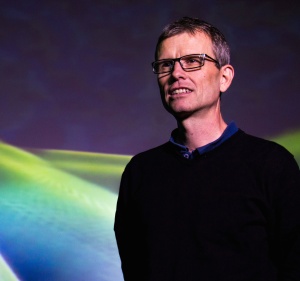
Synthetic Electro Replicant plays with synchronisation between image and sound. Most of the motion occurs over durations which are integer multiples of 0.2 seconds. Some timings are occasionally offset to create syncopation between image and music. The intention is to discover how a rigid musical timing structure interacts with tightly synchronised imagery. All the visual forms are created with a video instrument which generates vector based geometric graphics. These can be replicated to form complex forms and dynamically changing geometries. Colour is used to enhance the visceral quality of the video and interacts with the abstract forms to create richly coloured imagery.
Inspired by trance and other dance music genres a fixed 4/4 timing structure and tempo is the foundation of the soundtrack. It is primarily a beat based composition but the rhythm is preceded with a more textural introduction. Initially the textural sonic elements accompany the video in a loose and complementary fashion. The 150 bpm tempo grid is gradually revealed as the instruments become tightly locked to the beat as the music progresses and the shapes respond in kind.
Dave studies Music Technologies at Staffordshire University, teaching MAX/MSP, mastering and sound synthesis. He is a visual music composer and holds a PhD in Visual Music composition. His earlier research centred on sonification and auditory display and his composition ‘Listen (Awakening)’ was performed at the Sydney Opera House as part of the ICAD conference in 2004. His more recent work focuses on composition for Visual Music combining abstract animation and video concrete with various forms of electronic music. Dave also produces more mainstream electronic music and is looking at ways to integrate this more closely with his academic research.
Dave’s compositions have been performed at the Soundings Festival Edinburgh, MANTIS Festival University of Manchester, flEXiff Experimental Film Festival Sydney Australia, Seeing Sound Bath Spa, NoiseFloor Festival Staffordshire and the Understanding Visual Music Conference in Brasilia, Brazil.
Diego Garro – TACTO
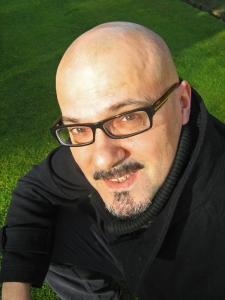
The title refers to ‘touch’ but the piece in actual fact strives to explore the senses’ response to crossfires of composed artistic messages. The poem, the sound and the images are all rooted in the quotidian. At the same time they depart from it, inviting the viewer to watch and hear elements with a sensory magnifying glass and use the insight into the textural, the cellular, the atomic layers as a springboard for a creative deconstruction, or reconstruction, of reality.
Stylistically the visuals engage with a timeless flirtation with the work of abstract expressionists such as Jackson Pollock, Willem De Kooning and Joan Mitchell. Thus it employs the poetic verse and sound design to bridge the works of those pioneers with the fresher approaches of the digital expressionism of recent years.
Through digital signal processing techniques, the tactile simplicity of the materials utilised in TACTO is deteriorated almost to a pre-technological degree. I composed the piece aware of contemporary digital perfections, whilst celebrating with an underlying sense of optimism life’s senseless flaws: the chaotic patterns of our skin surface, the duality of youth and maturity, light and darkness, the breaking down of speech into disorderly whispers, the elusive meaning of the words we speak.
Dr. Diego Garro is an artist and educator based in the UK. He studied Electronic Engineering in Padova (Italy) and then Electroacoustic Music Composition with Prof. Mike Vaughan and Prof. Rajmil Fischman at Keele University (UK). His research interests lie in creative digital media, artistic practices and compositional languages that bridge the sonic arts idioms with various aspects of visual arts, literature, poetry, foreign languages and popular culture such as Electronica, glitch, video, ASMR. His artistic and research outputs include audio and audio-visual works which are regularly selected and performed in the UK and abroad.
Elsa Justel – dots, lines and roughness
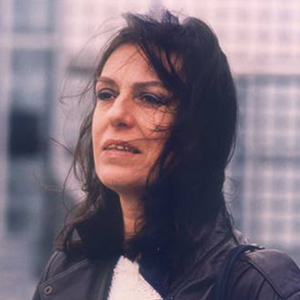
dots, lines and roughness (6’11) (2016)
music and image : Elsa Justel
Sounds made from different recordings of the same material sources used in the image (photographs of objects and films). Sound objects thus obtained were processed by computer and organized to create a musical form in temporal and spatial correlation with the movement and character of the image.
Infinite points generating lines, curves and filled shapes.
Increasingly close and deep, forming dense and rough textures able to create an infinite world of forms moving in space.
(Argentine-France)
PhD in Aesthetics, Science and Technology of the Arts at the University of Paris, Justel currently works as an independent composer and video artist.
Her works have received numerous awards in international competitions and were commissioned by the French government and different European studios. She has developed a pedagogical and research activity at the Universities of Marne La Vallée (France) and Pompeu Fabra (Spain) and several European schools of music.
Recordings by Empreintes Digitales (Canada) (http://www.electrocd.com/fr/bio/justel_el/discog/), and other publishers.
In 2007 she creates the Foundation Destellos to promote electroacoustic musica and digital arts, organizing an International competition.
Detailed biographic information: www.fundestellos.org/Bio.htm
Alfonso Pretelt – Eurydice.
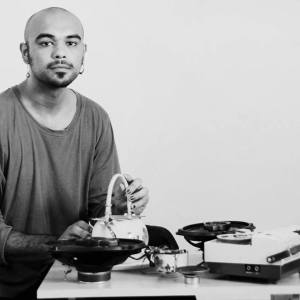
Proposes a pictorial scenario constructed by hand to be intervened with digital processes that characterise the image inside a digital support whose sonority wraps the scenery unifying with the image and visual behaviour converting audio data into graphic matrices. Also during the final rendering a signal error arises redirecting the piece towards aesthetic that integrates a failure by chance as a spiritual manifestation by the machine in a mounting where noise is suggested as leit motive.
This decision finally adheres to the discourse posed since the failure of the system and the technology of a worldview resulting from social and collective evolution.
According to Richard J. P. et Poésie profondeitr, daydreams of molten metals, which are like rivers, suggest the “blood of the earth” as values and chthonic powers.
J.E. Cirlot.
Alfonso Pretelt, Sound artist, Experimental and Electroacoustic musician, video artist and filmmaker. His interest and active participation in different disciplines and languages of the audiovisual and contemporary music leads him to work, to investigate and to study located in borders where they cohabit the plastic arts, video, performance and sonorous art, introducing in his work metaphorical human, philosophical contexts And sociocultural from the sound experience at the phenomenological level, situating it in a literary fictional context directed to an audiovisual narrative, there arises from there a very personal aesthetic where dialogues the sound and the image in a symbolic terrain inhabited by technology and thought. University studies in music, documentary film, electroacoustic composition and sonology, Master in sound art.
From 2011 to date has released Four EP and one LP of experimental and electroacoustic music and has published several pieces of video and visual music in its channel of Vimeo and official website http://www.ideofoniaancestral.com His artistic production in general has been selected and has been presented in festivals and spaces of the academic, cultural and Underground scene related to video art, sound art, electroacoustic visual music and experimental cinema in countries such as Germany, Sweden, Spain, Mexico, Argentina, Chile, Brazil, Colombia, the United States and the Netherlands. His works of visual and electronic music have been presented at festivals curated by Antenor Ferreira. UVM2015 and MUSIKHÖGSKOLANS KONSERTSERIE. University of Orebro.
In February 2017 he released his most recent EP under the pseudonym of Pathaphysician Model with the Colombian label TheBurros Discos. Currently carries out the development of an organic interfaces based on a litofono, stone, sound sculpture made by the same in the faculty of arts of the University of Barcelona during the course of the Master of Sound Art in 2015 as a personal research project in An intermediate field of work. This project has been invited by STEIM to be developed in its facilities. He studies contemporary music and sonology at the KonCon Royal Conservatory, a sonology institute in The Hague, Netherlands, where he researches and develops pieces based on generative uses of visual music on video.
Brian Hernandez – F.A.K. 120 Video Triptych (Part 2)
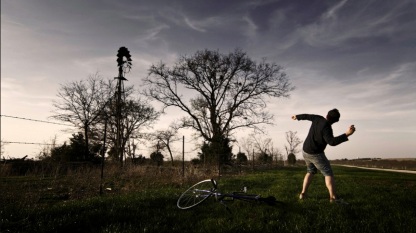
F.A.K. 120, video triptych is a four-channel audio and video work composed in 2015. This is the middle section, part 2. I chose to focus on the emotive aspect that can be communicated through the work, carefully considering the color palette and the morphological quality of the sonic and visual elements.
Brian Hernandez is an artist who works with video, electronic music, and writes for large and small acoustic ensembles. His works have been selected for performance across the USA, Europe, China, and Canada, in festivals and conferences such as SEAMUS, WOCMAT, SCI, and Cinesonika, to name a few.
He holds a B.A. in philosophy from St Mary’s University and an M.A. in music composition, from the University of North Texas. Currently, he is completing his doctorate in interdisciplinary digital media and performance at the Herberger Institute for Design and the Arts, School of Music, at Arizona State University, Tempe, AZ.
Fernando Alexis – Untitled#1

Light, glitch, loops…
It is at Concordia University that Fernando Alexis Franco Murillo discovered a new form of expression with electroacoustic music. His music is inspired from personal experiences and human emotions like love, sadness and anger. He completed a bachelor’s degree and a master’s degree at the Conservatoire de Musique de Montréal under the direction of Louis Dufort. As a “Canadian Council for the Arts” and “Conseil des Arts et des Lettres du Québec” recipient, his music has been played across Canada, United-States, France, U.K, Chile, Portugal, Spain and South Korea. His piece Qualia was awarded the 4th at the 2014 edition of the prestigious JTTP composition contest and his composition Noche Triste was awarded the 2nd place at the Mutek’s Fill the Music Box composition contest.
Maxime Corbeil-Perron – Northern
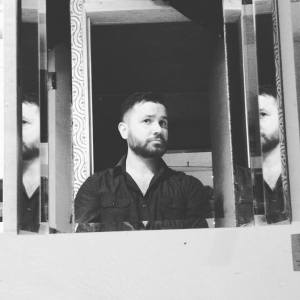
Shot spontaneously on a smart phone travelling on a train from New York to Montreal in spring of 2016.
Northern is a study of movement and colour – but it also bears the frenzy of travel, madness and love.
Maxime Corbeil-Perron is a composer and moving image artist whose work has been noticed by many international competitions and events. His work has been qualified as an «infinite cosmos» (Etherreal, 2015), «pushing the boundaries of abstraction» (Silence and Sound, 2015) and «defying any explication or labelling» (La Folia, UK, 2015).
He composes electroacoustic and mixed-media music, with a compositional approach that is inspired by electronic music, experimental cinema and visual arts – in a constant state of research to create an abstract, dynamic, spiritual and poetic sound-world.
He also composes and produces electronic music ( D R E S D E N, Le Poisson d’argent, Recepteurz), he is part of the drone/noise duo Political Ritual and the instrumental post-rock duo Le Pélican Noir. Also a moving-image artist, his audio-visual works have been shown in a many prestigious international film and digital arts festivals.
He collaborates with many local musicans (Félix-Antoine Morin, Émilie Girard-Charest, Ida Toninato, Sylvain Gagné, Marie-Chantal Leclair). He wrote a mixed-media piece for Siren Organ (an invented instrument by Jean-François Laporte, commissioned by Totem Contemporain) and recently completed a piece for tape and cello (commissioned by Émilie Girard-Charest, the piece will be available on the Ambiances Magnétiques imprint in 2016).
His work has received national and international prizes, among them the first prize from the Jeu de temps/Times Play competition (Canada, 2011), awarded by the Canadian Electroacoustic Community. A special mention and the Senato della repubblica Italiana medal from the Città di Udine international composition competition (Italy, 2012) and a second place (Motus prize) from the Destellos Foundation international composition competition (Argentina, 2012). The Musicworks magazine awarded two of his video work Ghostly, and his mix-media piece Vertiges in ex-aequo in 2013 in the Musicworks international electronic composition contest (Canada, 2013).
Since 2012, his work has been presented in over 40 international events worldwide and has been distributed by Vox Novus, Taukay Musicali, CEC Cache, Hardcore Jewellery, Ambiances Magnétiques and Kohlenstoff Records.
He is a founding member of the Kohlenstoff artist collective and co-director of the digital record label Kohlensotff Records, which focuses on the broadcast and distribution of new, unusual and experimental music.
He graduated with highest honours from the Conservatoire de Musique de Montréal, where he studied electroacoustic composition. He started a doctorat’s degree at the Université de Montréal in fall of 2015.
His work has been supported by the CCA and the CALQ.
Carlos Delgado – Prelude To The Fifth Sun
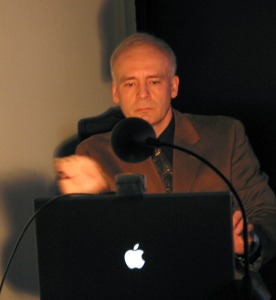
Prelude To The Fifth Sun is a soundscape composition for electronic sounds and video. It was originally inspired by the struggle of the Native American Hopi tribe for sovereignty over water resources in their ancestral lands. Today, indigenous peoples continue to peacefully resist the encroachment of corporate interests and the American government. The piece juxtaposes very familiar environmental sounds with unearthly voices and textures, weaving them with chant derived from the Hopi tradition. It is intended as a celebration of the sacred relationship between traditional cultures and their lands.
Carlos Delgado’s music has been heard in concerts, festivals, and radio broadcasts in Argentina, Australia, England, Finland, France, Germany, Hungary, Italy, Japan, Romania, Spain, and the United States. A composer who specializes in electroacoustic chamber music and multimedia, his works have been presented at venues such as Merkin Recital Hall in New York; the 11th Biennial Symposium on Arts and Technology: New Creativity at the Ammerman Center Auditorium, Connecticut; St. Giles Cripplegate / Barbican, in London, England; the Rencontre Internationale de Science & Cinema (RISC) in Marseille, France; the Strada Facendo Festival, in Pisa, Italy; the International Contemporary Music Week and the International Society for Contemporary Music’s World Music Days in Bucharest, Romania; and the BKA Theater in Berlin, Germany. His electroacoustic and acousmatic works have also been included in the 2011, 2012, and 2013 editions of EMUFest, the international festival of electroacoustic music held at Conservatorio Santa Cecilia in Italy, as well as the 2013 and 2014 Festa Europea della Musica festivals in Rome.
A winner of the 1996 Society of Composers CD Series Award, several of his works have been recorded by world-class artists such as Emil Sein, Corrado Canonici, Roger Heaton, and Beate-Gabriela Schmitt, and are available on the CRI (New World Records), Living Artist, Capstone Records, and Sonoton ProViva labels.
He has appeared as a laptop performer at Symphony Space and the Frederick Loewe Theater (New York); the Titu Maiorescu Romanian Cultural Institute in Berlin; the Musica Senza Frontiere Festival, in Perugia; and many others. http://www.carlosdelgadomusic.com